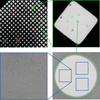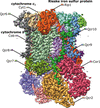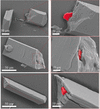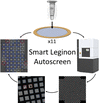issue contents
January 2023 issue

scientific commentaries
CRYO | EM
Cryo-EM has been used to analyze the positions of the hydrophilic domain of the Rieske iron–sulfur protein in a yeast complex III2 under various redox and substrate/inhibitor conditions.
CRYO | EM
Target selection for single-particle cryo-EM data acquisition sessions is mostly done manually by human operators, which is time consuming and leads to the inefficient use of instruments. The software toolbox Ptolemy [Kim et al. (2023). IUCrJ, 10, 90–102] provides solutions for automated target selection for cryo-EM imaging.
topical reviews
CHEMISTRY | CRYSTENG
CSD Communications have opened up a new pathway for sharing crystallographic data that are unlikely to be published in a scientific article, contributing to both the breadth and the depth of the CSD. This review discusses the benefits, challenges, mechanism and trends in these structures.
research letters
BIOLOGY | MEDICINE
A molecular-dynamics-based pipeline has been designed and implemented to emulate the entire process of collecting diffraction photographs and calculating crystallographic structures of proteins from them. The developed methodology should find a range of applications, such as optimizing refinement protocols to solve crystal structures and extracting dynamics information from diffraction data or diffuse scattering.
research papers
CRYO | EM
Cryo-EM structures of complex III2 under a range of redox conditions with or without exogenous substrates provide evidence for redox- and substrate-dependent interaction of the Rieske iron–sulfur protein with quinone in the Qo site and the cytochrome b and cytochrome c1 subunits.
PDB references: CIII2, consensus refinement, 8ab6; with atovaquone and antimycin A bound, 8ab7; ascorbate-reduced with decylubiquinone, Rieske domain in b position, 8ab8; ascorbate-reduced, Rieske domain in b position, 8ab9; ascorbate-reduced, Rieske domain in intermediate position, 8aba; ascorbate-reduced, Rieske domain in c position, 8abb; ferricyanide-oxidized, Rieske domain in b position, 8abe; ferricyanide-oxidized, Rieske domain in intermediate position, 8abf; ferricyanide-oxidized, Rieske domain in c position, 8abg; with antimycin A bound, Rieske domain in b position, 8abh; with antimycin A bound, Rieske domain in intermediate position, 8abi; with antimycin A bound, Rieske domain in c position, 8abj; with decylubiquinol, Rieske domain in b position, 8abk; with decylubiquinol and antimycin A, consensus refinement, 8abl; Rieske domain in b position, 8abm; Rieske domain in intermediate position, 8ac3; Rieske domain in c position, 8ac4; with decylubiquinone, Rieske domain in b position, 8ac5
CHEMISTRY | CRYSTENG
Download citation


Download citation


Unusual shape-preserved pathway of a core-shell phase transition triggered by orientational disorder
Orientational disorder defects present in the crystal structure of uric acid dihydrate trigger a solid-state dehydration phase transition inside the crystal prior to the competitive transformation mediated by solvent, forming an unconventional core-shell structure.
CCDC reference: 2163198
CHEMISTRY | CRYSTENG
Download citation


Download citation


The structure–property relationship between the 1,5-pentanediamine oxalate anhydrate and dihydrate has been analyzed and established. The influence of the polymorphism of the monomer and the polymerization methods on the properties of the polymer was also investigated.
CHEMISTRY | CRYSTENG
Download citation


Download citation


Simultaneous improvements in stability and solubility of six novel multi-component solid forms synthesized via the reactive crystallization of 8-hydroxy-7,8-dihydroberberine with a number of pharmaceutical acids were observed in comparison with the commercial form of berberine. The factors affecting solubility were determined to be cumulative contributions of the affinity of the counter-ion to the solvent, the packing index, intermolecular interactions, the molar ratio of drug to counter-ion in the product and the common ion effect.
CRYO | EM
Smart Leginon leverages new machine-learning algorithms together with new microscope and image-handling algorithms to enable unattended, multi-grid cryoEM screening. Smart Leginon Autoscreen reduces microscope operator time from ∼6 h to <10 min for a typical session and recovers substantial idle microscope time outside of normal working hours.
CRYO | EM
Ptolemy uses deep learning and computer vision to automate multi-scale targeting in cryoEM data collection. It accurately finds and ranks targets of interest (`squares' and `holes') at successive magnification levels and generalizes across samples and microscopes.
PHYSICS | FELS
Download citation


Download citation


Using K4[Pt2(P2O5H2)4]·2H2O as a test case, we present newly developed serial femtosecond crystallography data reduction software for small-unit-cell systems featuring sparse indexing, seed-skewness integration, an overlap-based combined Ewald sphere width and partiality correction, and a sophisticated post-refinement and merging procedure.
ELECTRON CRYSTALLOGRAPHY
Fine-sliced cRED data allows dynamical electron scattering to be investigated with high precision. Experimental and simulated data are compared for single-crystal silicon, showing the importance of accurate crystal orientation and many other corrections for obtaining good measurement statistics.
ELECTRON CRYSTALLOGRAPHY
Download citation


Download citation


The true molecular conformation and the crystal structure of three remarkable polycyclic aromatic hydrocarbons were determined ab initio by 3D electron diffraction, which allowed for direct ab initio structure solution and the unbiased determination of the internal molecular conformation. Detailed synthetic routes and spectroscopic analyses are also discussed.


 journal menu
journal menu




 access
access


























